The Story of the DuVersity – 25 Hazardous Years
Anthony Blake
The DuVersity was officially registered in 1998. It had its roots many years before. Its origins can be closely associated with John Bennett’s four volume work The Dramatic Universe, which was in part his reflection on the extraordinary novel written by his teacher G.I. Gurdjieff called Beelzebub’s Tales to His Grandson. Both books can be seen as attempts to include everything. The series of writings by Gurdjieff that began with Beelzebub was in fact called All and Everything (even at one time All of Everything).
Bennett attracted many people around him and in the 60s this included several young scientists like myself who were attracted to Bennett’s exposition of a cosmic vision of wholeness, embracing science and religion together, that provided ways of exploring and changing our very own consciousness to enable us to hold a cosmic vision. In our mutual exchanges we young men sometimes talked of creating a ‘Dramatic University’. It was obvious to us that education was seriously lacking in vision and depth. For this reason, Bennett had been friends with the educational pioneer Maria Montessori who in her own work included a cosmic education.
Cosmic education is introduced to children aged six to twelve as a representation of the whole world and the universe as a whole, with the aim of making them feel that they are a “cosmic agent”: the child is invited to embrace the whole world, broaden their point of view, look more broadly than the environment of their home, their school and their close knowledge. Montessori Action
During the time I was with Bennett I with others witnessed his encounters with the insights of spiritual leaders such as the Shivapuri Baba and Hasan Shushud while maintaining his investigative studies into how we think in the realms of physics and philosophy. His last life task was the creation of the International Academy for Continuous Education, a radical experiment in transmitting the ideas and practices of what was sometimes known as the fourth way introduced by Gurdjieff (but also developed by many of his followers).
Bennett was an exemplar of enquiry in the spirit of Gurdjieff, whose dictum was to take the wisdom of the East and the knowledge of the West and then search. He was au fait with the world of mathematical physics as much as with the realm of spiritual techniques, which many mainstream exponents of spirituality and followers of Gurdjieff found difficult to understand.
After he died Bennett’s students were forced to look at what they could do without him, so tried various ways of applying what they had learned. But there was always an inclination just to continue or copy the programme he had developed for the Academy at Sherborne, not allowing for creative innovation or further exploration. In my own case, I took up the task of editing and publishing his last thoughts in which I had found the emergence of new insights. In particular, I went ahead to produce a book entitled Deeper Man to represent one he had proposed – with the sexier title of Dig Deeper Man – but then died before he had created all the lectures upon which it was to have been based. But the book still became recognized as a valuable reference for fourth way ideas and practices.
I had often reflected on the good fortune I had had from being with a teacher with grounding in the natural sciences and mathematics. He was capable of arguing from experiment and empirical evidence rather than relying on mystification and authority.
I continued to experiment and explore, starting from the projects that Bennett had left us as works in progress when he died, for example to do with structural thinking, the nature of time, integration without rejection, higher intelligence and so on. In the cause of this I engaged, whenever I could, with people in various experimental workshops.
An important thread in the story comes from the quantum physicist David Bohm, who had been my tutor in Bristol University and also the supervisor of my colleague Henry Bortoft in Birkbeck, London. Bohm had visited Coombe Springs to talk with Bennett and some of us 1962 to ’64 but it was only after he had died that I heard of his work with what is called dialogue which appeared to me a strong candidate for a way of learning that did not rely on authority and hierarchy.
Joining up with psychotherapist Karen Stefano. I was persuaded to make a not-for-profit foundation the DuVersity, to further the aims of the lines of research initiated by John Bennett but not exclusively enclosed by his ideas. The mission of the DuVersity was stated as follows:
The DuVersity is concerned with the importance of diversity for the development of human intelligence. It seeks to improve communication in groups, encourage multiple viewpoints on the same reality, understanding how thoughts arise, and have insight into the way cultures emerge and are shaped by their encounters with each other. DuVersity is a universal phenomenon, beyond questions of race and gender.
The DuVersity is not identified with any religion, ideology, political view or scientific theory. It has developed its own specific tools for its research and educational programs.
The DuVersity has historical roots in the Systematics method mainly developed by the philosopher John Bennett in the 60’s and in the Dialogue process promulgated by the physicist David Bohm and the psychotherapist Patrick de Mare in the 80’s. It has been applying its ideas to the design of new kinds of conferencing, as in the series held in Baltimore since 1997. In 1995 it developed a new system of structured conversation. In 1998 it initiated a new area of study, the study of arrangement or pattern. In 2000, it began its series of working group seminars, based on many years of investigation into transformative education. It has continued a series of seminars based on the principles of understanding of Systematics since 2000.
The word “duversity” was a combination of DU from dramatic universe, and as an amalgam of university and diversity. DuVersity is a word indicating a kind of diversity that generates unity – just as the word universe translates quite exactly as turning into unity in an active sense. The word also has the merit that no one else uses it!
Interestingly enough, I always had a puzzle about Bennett’s title for his magnum opus The Dramatic Universe: what made it ‘dramatic’ in any obvious sense? Certainly, he spoke about an uncertain universe on all scales, but there was no explicit connection to the dramatic arts. His book could have been called The Meaningful Universe. However, these days I am glad of the dramatic name because it supports my ventures into theatre, of which more later.
The DuVersity made associations with many creative individuals and enterprises. Anthony worked knew them personally. It is for this reason that we have not included such major over-arcing influences as Gurdjieff whose passionate and wild all of everything genius is perhaps the most influential of all. Gurdjieff was, after all, the major influence on John Bennett. Also not included are such geniuses as G. Spencer Brown, author of Laws of Form, an English mathematician who understood the logic of distinction like no other, and Charlotte Bach whose ideas on evolution and the alchemical quaternary were without parallel. Anthony was privileged to study with them. There is also Henri Bortoft influential author of The Wholeness of Nature and Simon Weightman Head of Religious Studies at SOAS, London University, who were both students of John Bennett and friends of Anthony but were not engaged in DuVersity projects. All these people have now passed. Here are some more names, most of whom have passed but mentioned as an important part of our history.

Ted Matchett (1929-98) was a friend of Anthony over 25 years. Ted was a design engineer who transcended the confines of industrial design to develop methods of creativity of astonishing spiritual genius. Many DuVersity members revered him.
Edith Wallace (1909 – 2004) was a pupil of both Carl Jung and John Bennett. Her ‘playshops’ under the title Continuing the Quest are managed and assisted by Karen Stefano and use the method of tissue paper collage that she first developed while at Bennett’s International Academy at Sherborne.
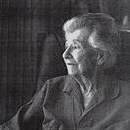

Joseph Rael is a shaman embodying both Ute and Pueblo traditions. He is an visionary artist and inventor of dances, but also a master of the Tiwa language of metaphor. He guided a DuVersity tour of sacred sites in the South West in 2001. His kindness and spirit has been of great support over many years.
John Allen met Bennett and Blake around 1970. He was the visionary creator of the Biosphere 2 project in Arizona in part conceived, built and managed through Bennett’s systematics. A dramatist and poet he has been of constant stimulation over many years and continues to meet and dialogue with Anthony.
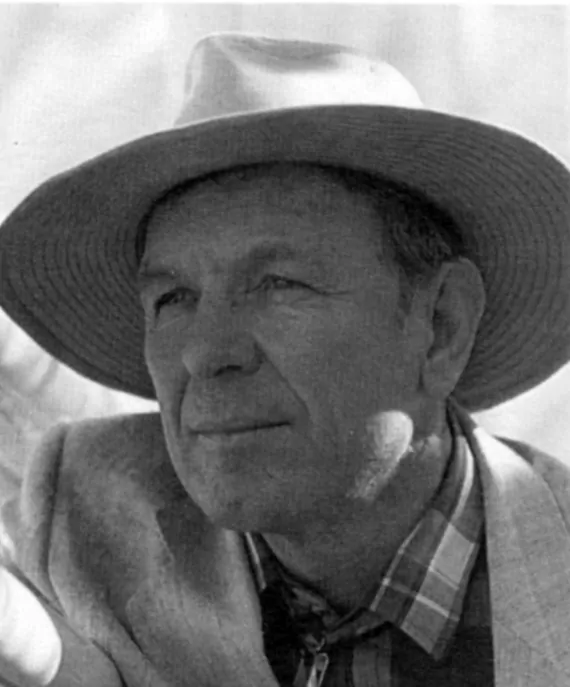
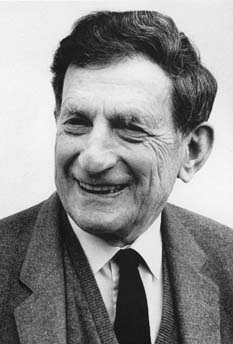
David Bohm (1917-1992) was physics tutor to Anthony Blake and dialogued with Bennett (1962-64). He was a leading proponent of the dialogue process. His ideas continue to inspire and guide our work.
Patrick de Mare (1916 – 2008) had 60 years of experience in working in groups, including working with Foulkes and the Tavistock Institute of Human Relations during the Second World War. When Bohm’s psychotherapist, he introduced him to his ideas on dialogue, which were later developed into the ideas of koinonia (impersonal fellowship) and the median group (between the small and the large), which we have incorporated into our own programs.

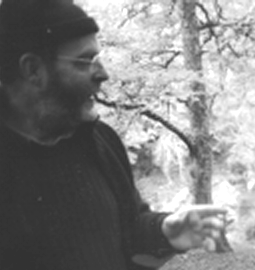
Anthony Judge was director of UIA (Union of International Associations) based in Brussels and responsible for the encyclopaedic World Problems and Human Potential and one of the most brilliant and insightful critics of present day attempts to think globally and in large groups. He was co-founder of the School of Ignorance where Anthony Blake had some of his early major experiences of the dialogue process.
Gordon Lawrence developed the Social Dreaming Matrix that we used in the Working Group method. Anthony made several video-dialogues with him.
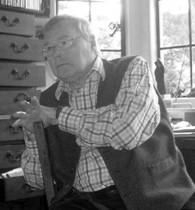
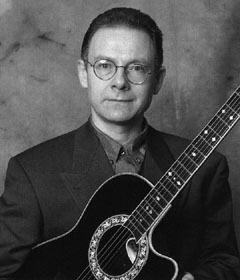
Robert Fripp leader of the group King Crimson developed an extraordinary training called ‘Guitar Craft’ that introduced hundreds of people to ‘the work’ by practical and artistic means. He brought his ‘Soundscapes’ to the first Baltimore seminar-dialogue and has remained a wonderful friend for many years.
Warren Kenton was a leading light of Kabbalah in the UK and someone we have known for almost 30 years. First trained in the Gurdjieff work he was sympathetic and helpful to us.
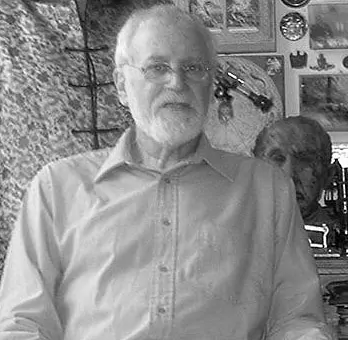

John Anthony West was a leading Egyptologist and guided a DuVersity tour into the sacred sites of Egypt in 2000.
Richard Heath was our guide in the Enchanted Albion logosafari. Author of Matrix of Creation and Sacred Number, he worked with Anthony Blake and John Varney on Logovisual Technology.

William Pensinger was author (with his wife Nha Trang) of the outstanding novel Moon of Hoa Binh and many papers on the underlying deep structure of reality beyond and encompassing object and subject.
We should include all those who have contributed to our seminar-dialogues, first held at Jerry Toporovsky’s Center for Holistic Health, not otherwise mentioned. These are:
Stanley Crouch jazz writer, novelist and script-writer.
Priestess Miriam head of the Voodoo Church in New Orleans.
Candice Peart biochemist and author of Molecules of Emotion.
Eliyahu McLean active in peace work in Israel.
Mae Wan Ho leading geneticist and author of The Rainbow and the Worm, which presents a new theory of life.
Jack de Johnette drummer extraordinary who works on using sound in healing with his wife Lydia.
Coleman Barks poet renowned for his versions of Rumi.
Jason Kheen expert in rave culture affiliated to Fraser Clarke pioneering leader of alternative culture in London, UK with whom Anthony video-dialogued in 2002.
In following on from the creative projects of Bennett, the DuVersity produced a series of yearly conferences beginning with All and Everything in 1995. In the end, though, I felt that experts in the various disciplines or systems seemed incapable of communicating with each other. This is brought out for me by the comments made by Anthony Judge on the conference of world religions held in Chicago in 1999. He said that the leaders brought their own clique and never really talked to each other. The declarations they released at the end were insipid and pointless.
Through the initiative of Karen, the DuVersity undertook a number of expeditions starting with one to Egypt under the guidance of John Anthony West. Three followed, one to the American Southwest under the guidance of the Shaman Joseph Rael. Then came one to Peru led by William Sullivan who had been a student at Sherborne on the fifth course and had been stimulated by the book Hamlet’s Mill a copy of which I thrust into his hands.
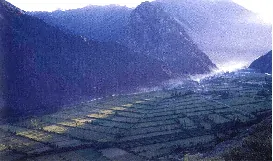
Saturday, 21st June/ Solstice Ollantaytambo
Amongst the sites explored was the so-called Sacred Valley of the Incas that seems to have been worked to depict astronomical objects and knowledge on a very large scale. Among these objects is a pyramid of a form previously unknown.
The last expedition was to Enchanted Albion, guided by Richard Heath, and took us through northern France and Britain, mainly to megalithic sites such as Carnak and the Orkneys. This itself was an echo of the trip I and some other Bennett students had made in 1966 looking at chapter houses in France in relation to the design of the marvellous building, the Djameechoonatra, that Bennett and his colleagues had designed and built, but which was destroyed by Idries Shah after Coombe springs was given to him in 1966.
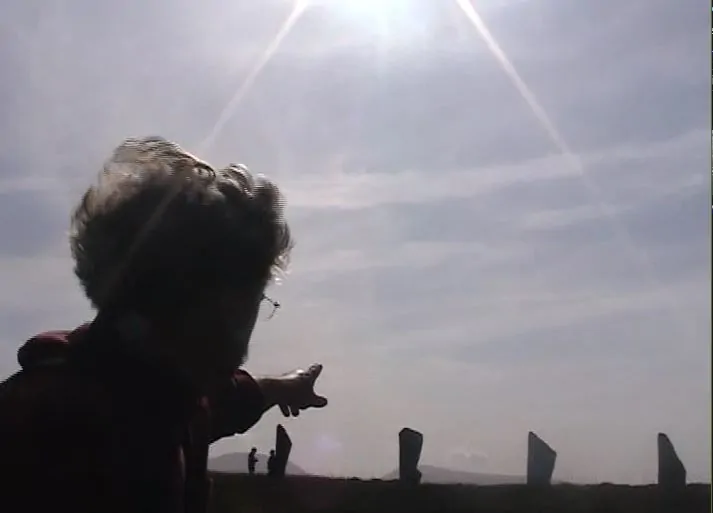
Richard Heath and stone circle in the Orkneys
In the realm of ideas, I launched a series of workshops from the year 2012 to address the principles of what Bennett called systematics. This led to practical design in both software and hardware to facilitate structural thinking that became called LogoVisual Technology (LVT). This began from the method of structural communication devised by John Bennett in the ‘60s. In those early days it even led to the invention of a teaching machine called the Systemaster. This technology was developed before even pocket calculators were available and used electromechanical apparatus. Structural communication technique was used in some schools and organizations where it developed into using magnetic hexagons. At present Board members Daniel Proudfoot and Jason Joslyn are working on a version to be used as an App.
Richard Heath and stone circle in the Orkneys
The equivalent to Bennett’s psychological groups went on developing as experimental workshops with such titles as ‘working group’ and ‘psyche integration’. I was looking for a truly integrated structure of methods, following Bennett’s lifetime work, particularly his last schematic of the Sevenfold Work. The sevenfold structure we used was:
Inner exercises – Bennett
Movements — Gurdjieff
l.VT – Bennett at al
Tissue paper collage — Wallace
Social dreaming matrix— Lawrence
Dialogue (Median Group) – de Mare
ILM (Neural Education) – Matchett
An aim of this programme was to integrate the methodologies of the Fourth Way with elements from more mainstream psychology. I was very keen to acknowledge the original work of pioneers in group process such as Wilfred Bion and Foulkes from the Northfield Experiment and Patrick de Mare and Gordon Lawrence from Tavistock and other centres. They contributed very much that was not known or appreciated by most followers of Gurdjieff and Bennett. A colleague Dr. Russell Schrieber wrote a significant book – Gurdjieff’s Transformational Psychology, the art of compassionate self-study – on the need to supplement the Gurdjieff psychology with elements of contemporary psychotherapy in order to make it work.
We were then hit, as everyone was, by the advent of Covid which shut down most of our programs. This gradually led to the adoption of such systems as Zoom to run online sessions where people could meet and talk together and even sometimes practice inner exercises. The DuVersity is fortunate in having members who are artists and creative in their own right. But, perhaps the main ingredient of our designs came from our growing experience of dialogue.
Dialogue is important because it points to a way that is not a continuation of authority-based systems based on teachings. My personal attitude is rather trenchant in regarding the death of authorities such as Gurdjieff and Bennett, as having a silver lining through leaving us all, as Gurdjieff said, ‘in galoshes’. It gave the opportunity for something new to come into play. This happened to dovetail with what I learned from psychologist Gordon Lawrence who proposed a choice between the ‘politics of salvation’ and the ‘politics of revelation’ in the realm of conversation: in the first the group looking for answers outside of themselves {save us! save us!} while in the second the group looks for the meaning arising between its own members.
In speaking of the importance of artists, I also referred to Gurdjieff as an example. He was a superb writer, composer and creator of dances as well as a man capable of subtle improvisation in the moment which can be considered living theatre.
Our online evens began in 2020 and covered many themes, such as different worlds, hyparxis, languages of function, being and will, hazard, the sacred rascoorano and the holy planet purgatory. These were not dealt with as expositions or lectures but in a way that encouraged participants to articulate their own concrete experience. We brought into the sessions as much music, poetry, drawing and dancing as we could manage.
SOME Impressions of the DuVersity
When I first encountered Anthony Blake at a weekend seminar in Baltimore in the early nineties he lit a spark, opened a new way of thinking that for me was new and exciting. In that case it was in understanding and experiencing number, which led to my fascination with systematics. The light that spark lit has never gone out as I have continued working with him for over thirty years. Later seminars dealt with systematics, structured communication, dialog, group dynamics, creativity and historical understanding of The Work. He introduces the Gurdjieff-Bennett Work in refreshing new ways that keep it alive for me. He empowers individuals to venture into new and creative ways of thinking. He challenges the authority of dogma, encouraging and enabling one to experience and understand self and reality from endlessly varying perspectives. Finally, working with the DuVersity is always, for me, the highest form of fun!
Initially Taking advantage of the constraints of the Covid times the series of monthly on line events have made it possible for many people to work with Anthony and each other on a regular basis, and at a cost that can’t be beat. It is such a gift. Thank you.
Leslie Schwing
Anthony Blake never ceases to challenge my perception of reality.
I remember working on a program where one of my co-workers wanted to sit around all day and talk about books. He was fond of saying, “It’s all one” and walking away from any conversation as if that proved his point. But he did tell me about a book by Ouspensky and I got a copy and it started a lifelong study of the Fourth Way. As I got deeper into the literature I wanted to find someone who could teach the movements and knew the exercises, I wanted to go beyond the books and learn how to deepen awareness and felt like I had a golden thread and was winding it into a ball. Eventually I heard about Claymont and then heard that a Fourth Way teacher was actually coming to Nashville. I was delighted and spend a weekend at the Unitarian Church with Anthony Blake. I signed up with his organization and learned he was coming to America once or twice a year. I started saving some money and when he would show up I would try my best to attend and found it the perfect venue. I had read the books by Ouspensky and Gurdjieff and while, that was exciting stuff, it was dated, and here was somebody bringing these ideas into the contemporary world with insight and humor. I was drawn to it like iron to a magnet, like a bee to pollen. So here’s a tip of the hat to Anthony Blake for all these years of exploration and adventure. Michael White
Michael White
DuVersity is a living experiment in motion, full of hazard, not sure where it is going or what it is doing, with a Motley crew daring to try and actually learn from time to time. It is a place where I find comrades and where it feels, the Work lives, not as some statue frozen in time but like life and intelligence, on the frail edge of the universe seeking to evolve and respond to now. It is where the myth of the leader crumbles into a new model of collective undertaking, but where Tony has been essential to help us risk this kind of change.
I like it and the journey it affords.
Peter Bassett
The DuVersity has been an invaluable resource for discovery, exploration and community of 4th way ideas for me over many years. Through DuVersity I’ve expanded my understanding on varying concepts from the in-depth readings, seminars and session topics which collectively blend art, writing, theater, music, dance, science and systems to cultivate practices relating each to the other. These artistic relationships give rise to a new metaphor for how we think about ourselves and others – intellectually, emotionally and societally now, and into the future pushing intergenerational intelligence. The process flips the narrative for change and transformation and finds its ‘mind’ in conversation with other minds, much like a cells adaptive collective process. Ultimately, DuVersity is about a place for the world to be itself.
Francine Marchetti
My explorations in dance, my branching spiritual journey, and my personal life have been to me, since childhood, as a three-strand braid. To this very day I am surprised, in wonder even, when looking out, how many synchronous loopings of people, places, studies, and events have, over the years, woven together in astonishing patterns bringing me to this very moment of experience and understanding.
Top of my mind says, DU is a really good conversation with fellow travelers. I’m even grateful for the Zoom sessions! They have expanded my awareness of friends in a wider world. I treasure seeing faces, hearing words, questions, experiences, responses of kindred hearts and minds.
DuVersity pushes, stretches, allows my experience, my point of view at the table, bows my head to rest, listen, learn from others in dialogue. Anthony’s design to involve the wider Arts in the ongoing study is a gift! For many of us, that is our book, our teacher, our guide. Thank you for inviting my dance into the conversation!
Travis Jarell
DuVersity as an organization understands we know little of the human situation and we have a right to “… work out your own salvation with diligence” as is echoed in various traditions. We start from nothing but open-ness to the human condition using all we know and can do; discarding form and method that have lost meaning.
We are not on anyone’s philosophic team nor do we promote uniformity of thought but in all things we lean toward “integration without rejection”.
Each has a part to play in a personal as well as a collective development. DuVersity is a space for each to find, by our own lights, where we fit in this unfolding miracle of life.
Daniel Proudfoot
New Projects
Third Force Theatre
The roots of this lie within the report by Orage that Gurdjieff that his book Beelzebub’s Tales was for the future and, in particular, for artists who might take ideas from it for their own work. I heard about this idea during the time I spent with John Bennett. I was attracted to the idea of engaging with Beelzebub not by trying to ‘understand’ it but by enacting it, and by creating stories of my own. It might then be possible to ‘fathom the gist’ of it in a third reading as he put it in his preface.
It was inevitable that such thoughts would have led to theatre and performance. Gurdjieff himself had depicted a Babylonian Society of Adherents of Legominism engaged in designing the arts as ways of transmitting real knowledge to future generations. In the chapter ‘Art’ he speaks of the Saturday night meetings which were actually just the practice we call improvisational theatre today. It so turned out that I had run a group in Kingston in 1970, where there were some students of Bennett left behind when he had gone to Sherborne, that was centred on role-playing. Looking at some documents lately I saw that I had been helped and influenced by visits from Keith Johnstone, a key representative of improvisational theatre in the UK and elsewhere. Sadly, by the time I realized this Keith had died (2023) and I could not get in touch with him. But, to my great fortune, I had been in active collaboration with Jessai Jayhmes, an actor and director, who first met me around 1980 and I met again just a few years ago.
It was wonderful to have the chance of participating in physical theatre and we realized this in his seminars we ran at Claymont and Camp Caravan. But this also did not exclude studies of classical dramatic structure and the possibilities of meta-theatre.
Gurdjieff’s pupil Orage had argued for a formal theatre based on Gurdjieff’s concept of the three brains. I quote the article he wrote in 1926 about this. In looking at this recently, he came to me that it might have been Orage who gave Gurdjieff the idea of improvisational theatre.
In conversation recently with a number of the intelligentsia (meaning no less, in America, than people interested in the Little Review) the topic perambulated round to the theatre. Wishing to make an experiment for my own curiosity, I asked everybody present to recall the occasions, within the previous twelve months, when he or she had been to a theatre for no other motive than to see a play for their own pleasure. In the confessional it turned out that nobody had once gone to a theatre for the sake of the play alone; there had always been auxiliary motives of an extraneous character, such as a dinner party, the obligation to write a notice, personal interest in a playwright or performer, and so on; and at least nine times out of ten this auxiliary motive was really the principal motive. In fact, but for the tradition of the theatre, the same motive would have taken them to any other place as readily as to a theatre.
As this had been my state, I was interested to have it shared by people worth respect; and my next question could now safely be put: “What is the kind of play that anybody present would like to see produced?” For it is obvious that unless either we can define the kind of play that would for its own sake interest us, or have the fortitude to wait for such a one to appear miraculously out of the blue, the theatre is not really for us, but only for our guests and hosts and unemployed associates. In short, it is not in any degree an art value, but only an entertainment—and rather dear at the inconvenience.
To my question, however, there was little positive response. (Why is it that people articulate on paper are so often dumb in original conversation?) I tried, in vain, to stimulate their interest in their own imagination. The drama, I said, began as a Monologue, became a Duologue, and is now a Triologue. Practically all modern plays consist of a triangle surrounded by minor geometrical figures. Is it inconceivable what the next evolutionary step must be?
A half-original suggestion was made that is just but only just worth recording. “It’s quite true,” the hominist said, “that every variety of the triangle has been staged. Come to that, most men have staged every sort of triangle in their personal experience, and the stage has nothing on them. But I would not mind seeing the triangle twisted occasionally to exhibit two men in conflict for the same woman. We see this triangle often enough in nature; but apparently it is not frequent in human nature. The theatrical convention, at least, is the dispute of two women about a man. When two men dispute over a woman—on the stage—it is usually a walk-over for one and the other permits himself to be walked over. I’m not suggesting that blood should be their argument; but I would like to see a battle of manly intelligences.”
This idea is only half-original because, obviously, it does not give us a new initiative to drama comparable, let us say, to the substitution of three characters for two or two for one. It still leaves us with the eternal triangle. But there being no further suggestion, I was bound to produce my own—neither of them I avow, really my own, if only because there is nothing really one’s own under the sun.
The first was suggested by a recollection. Several traveling theatrical companies found themselves marooned together over a certain Sunday on one of the desert islands called in America one-horse cities. To wile away the time, one of the party suggested that each should play a role he or she fancied, and get it professionally passed upon by the rest. To this was added the better suggestion that if one of the party would begin improvising in his selected role, the rest should come in as the occasion offered and continue the original improvised plot in his own selected role and on his own invention. The moment must have been creative; or, let us say, the planets must have been auspicious. The play lasted three hours; everybody in the three companies, to the number of sixteen, took part in it; the construction of the play was technically excellent; and the plot was rounded off to a satisfying finale. In the recollection of the whole tribe, no play or playing had had half the “go” of this improvised master-piece. They returned to the stage and to us with a golden dream.
“Suppose a company were to promise improvisation—would you” (I asked my friends) “go to see it, not from any auxiliary motive principally, but from the principal motive of curiosity? Assume that the idea were taken up by competent players who would adventure their success on their ready wit—would you go, even alone?”
It is significant that every person present replied with an emphatic affirmative. Now then, Theatre! You know at least something which would really intrigue “us.”
The second suggestion, again, was inspired by a recollection, but this time of a Russian play, produced or not produced, I am not sure which. The idea is to exhibit on the stage human psychology as it really is; that is to say (remember I speak as an intelligent to the intelligent—none of your “of, by or from”)—as mechanically determined by the sum of our experiences, instinctively, emotionally and mentally. Each of us—even “us,” is a marionette of a body whose behavior dances to the pulls of circumstances upon its three main pivots. Our behavior, in fact, is the resultant of three pulls, which seldom coincide in direction. My idea is to stage the facts as follows: At the side of the stage a three-storied erection would be placed; and in each of its rooms, open to the audience, a character would appear and there remain throughout the play. The top storey would represent the mind, the second the emotions, and the bottom storey the instincts or physical appetites. On the stage itself, the leading role would be played by a character whose every speech, gesture and procedure would be the resultant of the conflicting advice offered him by the three players, representing his own three “voices.” He would have no “will” of his own; but his behavior would be dictated by the relative strengths of the three pulls as represented by the three players “in him.” There would, moreover, be room for much variety. It is clear that people differ not wholly but only in the distribution and relative development of their three chief functions. One, for instance, has the brain of a man, the emotions of a child, and the appetite of a savage. Another has the brain of a child, the emotions of a poet, and the appetites of a dog—and so on. The resultant behaviors as manifested by the living automaton on the stage itself would be highly entertaining, might be extremely instructive and ought to be truly illuminating.
I do not, of course, undertake to construct a play adapted to this method of presentation; but, as one whose interest is centered in human psychology, I do undertake to go to see such a play attempted.
Having thus delivered myself with the modesty proper to the original source of the provocation to the discussion, I waited for the verdict. Alas, all my friends were asleep but one, and she had not listened to a word. It is at her request that I repeat myself thus.
Post Gurdjieff Beelzebub
In a collaboration with Jesai Jayhmes, Anthony ventured into the possibilities of rendering Gurdjieff’s Beelzebub’s Tales into performances. Thy formed a small group that met online with readings under the tuition of Jesai. This segued into me writing new scripts based on Beelzebub, the first being The New Design on the further design of the spaceships Gurdjieff described in his book. Anthony was annoyed by the almost total absence of women in Gurdjieff’s text, so he also invented Zeinab (the name taken from Gurdjieff’s scenario for The Struggle of the Magicians) as the granddaughter of Beelzebub!
This led to writing a script about What happened in Purgatory. Zeinab and Hassein are depicted as in Purgatory itself. It was an exercise to see what could be said and began from the previous writing on the new design of spaceships which introduced Zeinab and placed he visiting her father, a research scientist based on Purgatory!
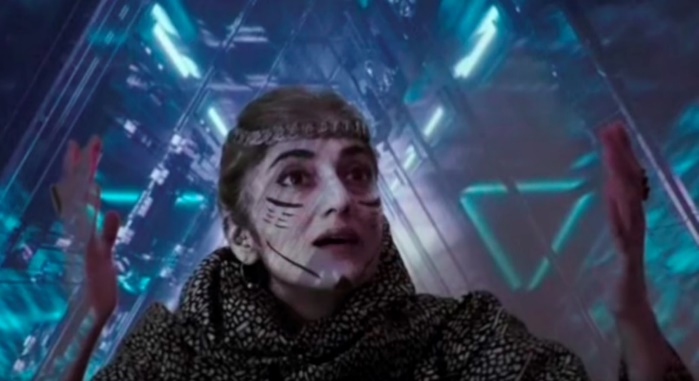
Zeinab played by Tabasheer Zutzsi
Hassein played by Jesai Jayhmes
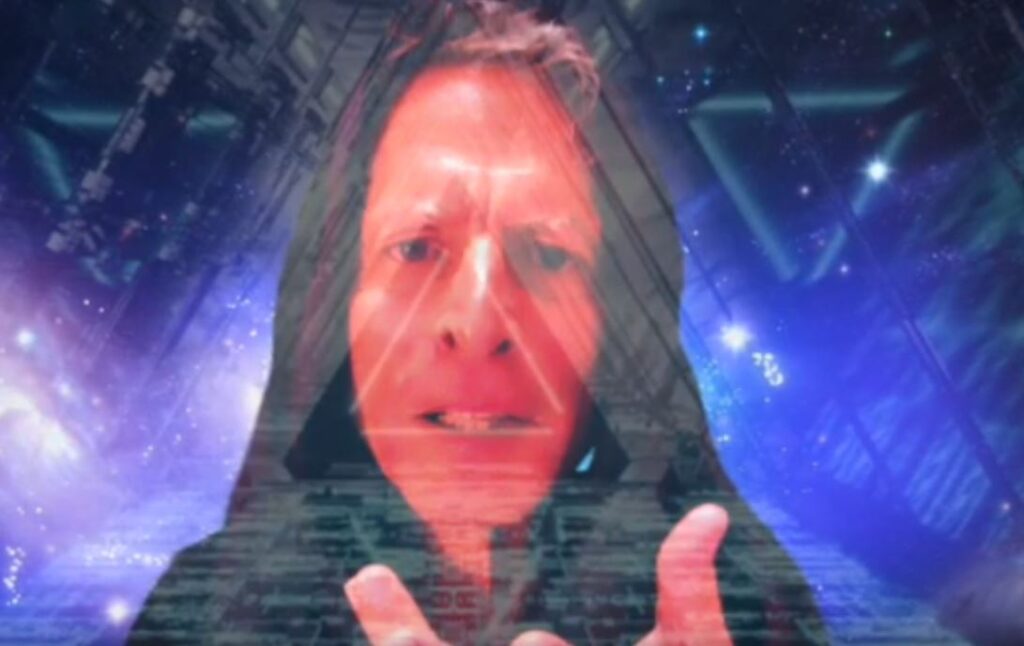
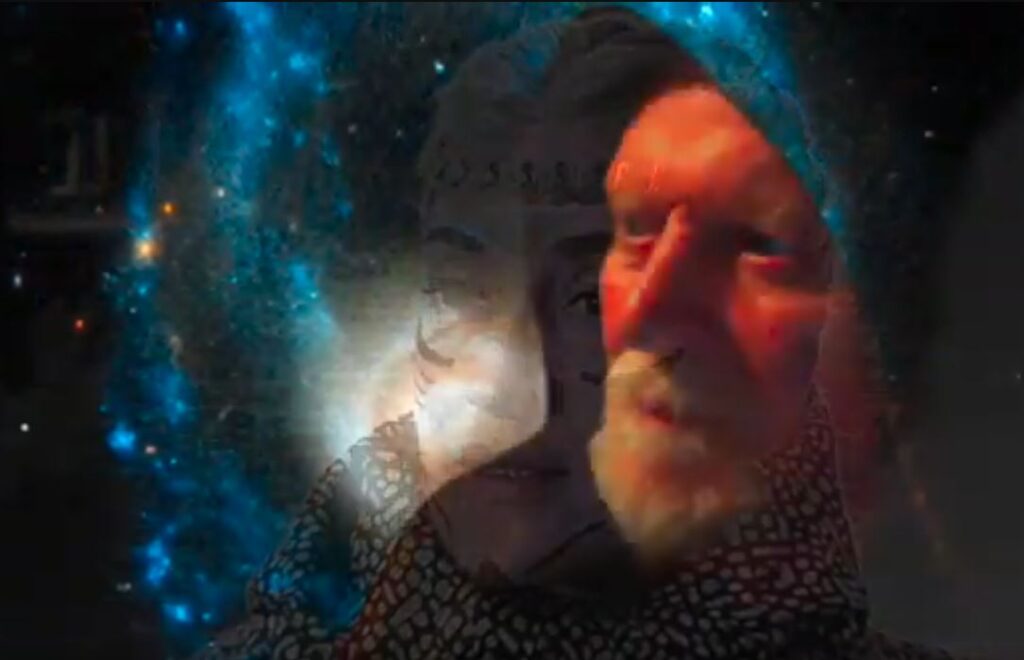
Beelzebub played by Anthony Blake
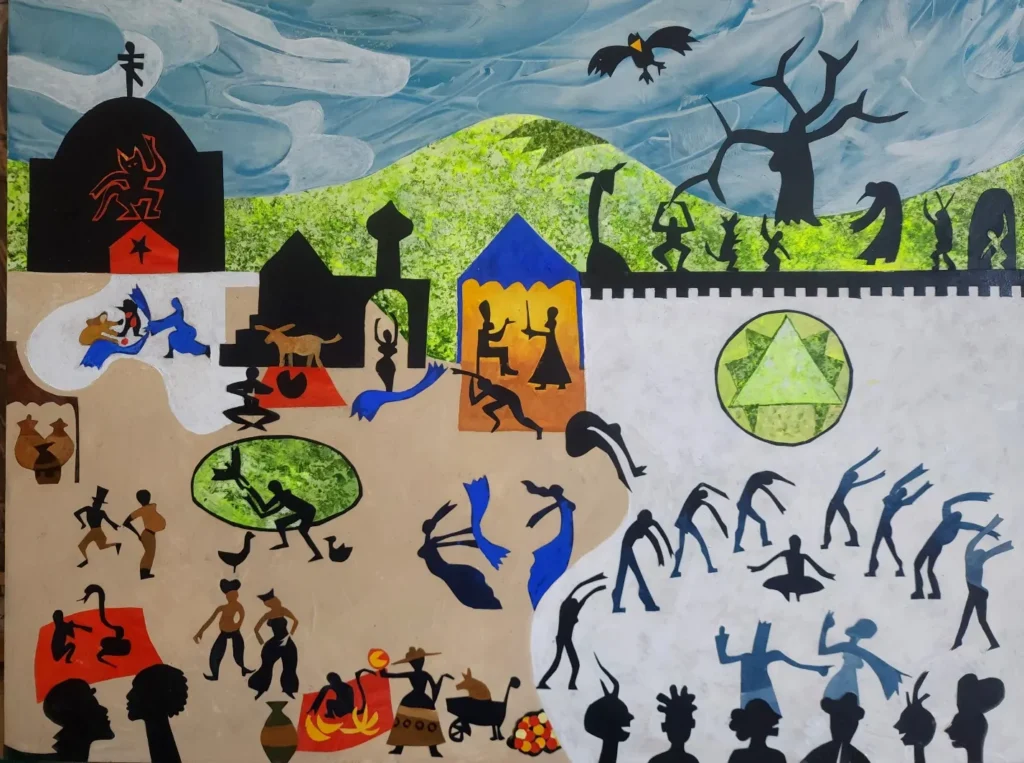
Improvisational Theatre
Struggle of the Magicians by Leslie Schwing – from Seminar in 2023
In 2023 conditions opened up and became possible to have seminars ‘in the flesh’. Two events happened, one at Claymont Court in West Virginia and the other at Camp Caravan in Massachusetts. It was through these workshops that we evolved the idea of a ‘Third Force Theatre’.
The fourth way, the way articulated now more than a hundred years ago by Gurdjieff, goes beyond any set of practices. As he said, more than once, it arises according to need from time to time and goes beyond any known form. In spirit, it is always creative. It makes use of whatever is available in the time and place of its manifestation. Most people see the Gurdjieff work in terms of such things as the movements or inner exercises but it is far more. Gurdjieff himself showed how it could manifest within the creative arts. He himself was a writer, musician, teacher of dances and could transmit teachings through communal meals and travels. He was a theatrical innovator, as in his project he called the Struggle of the Magicians, which led to major public demonstrations of the Movements in Paris and New York in the 1920s. In his book Beelzebub’s Tales he depicted wise men using the arts to transmit ideas to future generations by what he called legominisms. In these stories, he represented the meaning of the word theatre to be ‘reflector of reality’. The word itself comes from the old Greek word for ‘seeing’ as in theoria. As I have said, it is likely that Gurdjieff had picked up the idea of improvisational theatre from Orage who, as described in his paper we quoted earlier, had come across the method by accident.
As it generally known, the fourth way is intended to be practised in life. One of Gurdjieff’s sayings, echoed by his pupil John Bennett, was: in life to play role outwardly but not identify inwardly. Some of his movements were designed to demonstrate this and many contrasted outward behaviour with inner state. This is the core of understanding acting, which begins by grasping that in life we are always acting anyway, but largely unconsciously. We don’t get to see this just by wanting to or trying ‘to be aware’. It is necessary to experiment. It’s only by consciously playing a role that we can see the unconscious roles that make our lives mechanical. Attempts to be more aware are very limited in scope. We need to find creative ways of getting into another place of seeing by action, action that is not composed of routines.
Here I must comment on Gurdjieff’s attitude towards the study of types. Two things were important. One was that such studies could not be a science, but should be an art. The second was that, in order to see one’s own type, one had to put oneself into the role of another one.
Some of you think you can see types but they are not types at all that you see. In order to see types one must know one’s own type and be able to ‘depart’ from it.
ISOTM p. 247
There cannot be proper outward considering while a man is seated in his chief feature,” said G. “For instance So-and-So” (he named one of our party) “His feature is that he is never at home. How can he consider anything, or anybody?”
I was astonished at the artistic finish of the feature that was represented by G. It was not psychology even, it was art.
And psychology ought to be art,” G. replied, “psychology can never be simply a science.”
ISOTM p. 267
To do this, we need each other, the eyes and ears of our companions. It is now well attested in psychology that most of the time we do not know our own minds, though most of us believe we do. Looking inward in any obvious sense – ‘trying’ to se ourselves – is not enough, because such looking is itself conditioned. We cannot see ourselves just by wanting to. We need the eyes and ears of other people. And we need to reveal ourselves to them. We cannot expect to find some guru to act on us as an agent of ‘real consciousness’. We need to find ways of cooperating with others to enable this to happen between us.
What I say will seem didactic. But the only way of discovering ourselves, of finding ourselves out, is by doing rather than thinking. It means, at least, acting in a way that is not part of our routine. So, if you feel like taking up the challenge, join us in this fourth way venture. Characters or protagonists in the drama of the fourth way, such as John Bennett, well understood that any practice tends, after a time, to become another conditioning. It always remains important to break the mould. People may be astonished to know that, in his book Transformation, he claims that students of the work should not go on doing the movements after a few years or so!
Third Force Theatre is just a name. But, it might come to signify for you the intrinsic spirit of experiment and innovation which makes life real. Or, as John Bennett put it in his magnum opus, helps us realize our place in The Dramatic Universe. Things are not what they seem. Real achievement has to be hazardous. Creativity comes out of the void and not the known.
As the great bard said: the play’s the thing. Can we wake up to the way our lives are scripted so that we remain blind? And do this in a way that is full of laughter and play? To grow up enough to be young again?
